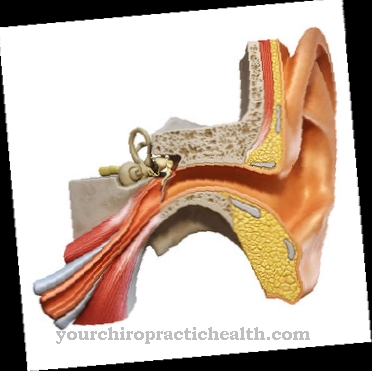The Peters Plus Syndrome is a very rare eye disease in which the development of the anterior segment of the eye is disturbed. The disease is based on a gene mutation. In treatment, the focus is on relieving the resulting symptoms. Corneal transplantation is a therapeutic option.
What is Peters Plus Syndrome?

© crevis - stock.adobe.com
At the Peters Plus Syndrome or Krause-Kivlin syndrome it is an eye disease that is hereditary. The medical literature describes only around 20 cases; the disease is not only very rare, it is also one of the rarest diseases.
Doctors use Peter’s anomaly as the main symptom, which is characterized by a malformation of the anterior chamber of the eye. Only since 1984 has medicine been describing the Peters-Plus-Syndrome as an independent syndrome that can be distinguished from similar clinical pictures.
causes
The cause of the Peters-Plus-Syndrome is genetic. The developmental disorder of the anterior segment is due to a mutation in the B3GALTL gene. Each gene codes a specific sequence of amino acids that make up proteins. This creates various structures and signal substances. The B3GALTL gene contains information about the synthesis of an enzyme that acts as a biocatalyst and promotes biochemical processes in the body. In this case it is beta-1,3-galactosyltransferase.
Among other things, this enzyme takes part in the synthesis of sugar chains. According to a new study from 2015, the mutation could lead to a disruption of quality control in the endoplasmic reticulum. The endoplasmic reticulum is a structure within human cells that is responsible, among other things, for the transport of substances.
Peters Plus Syndrome is inherited in an autosomal recessive manner. The disease only manifests itself when both parents pass on a mutated allele to the child. As soon as there is a healthy allele in the genome, the clinical picture does not develop. The affected allele is on an autosome, that is, not on a sex chromosome.
Symptoms, ailments & signs
The most important sign of the Peters-Plus-Syndrome is the so-called Peter's anomaly. This is an abnormality of the eyes, which is characterized by an underdevelopment of the anterior chambers of the eye. The anterior chamber is located behind the cornea. Peter's anomaly leads to a malformation of the lens and thus possibly to a cataract in which the lens of the eye is cloudy.
Those affected experience the cataract as a cloudy haze in their vision, which can be associated with greater sensitivity to glare. In addition, the iris may stick together in the chamber angle. Peter's anomaly can also cause nystagmus. These are rhythmic eye movements that are beyond the control of the person concerned. The syndrome leads to glaucoma in half of those affected, which puts the optic nerve at risk.
Furthermore, those affected often suffer from short stature, brachydactyly (shortened fingers and toes), a cleft palate and hypermobility. The latter is characterized by unusual mobility of ligaments, tendons, and joints. People with Peters Plus Syndrome often have a small head, a round face, and noticeably large cerebral ventricles.
The philtrum and fontanel are above average. Heart defects, kidney disorders, respiratory diseases, clinodactyly and polyhydramnios can also be signs of Peters-Plus-Syndrome. Motor and mental development may be delayed as a result of the various symptoms.
Diagnosis & course of disease
The characteristic malformation of the eyes, the resulting symptoms and the general clinical appearance provide the first clues for the Peter Plus Syndrome. Ophthalmologists can differentiate the symptoms from other diseases by performing detailed examinations.
In terms of differential diagnosis, doctors must primarily consider Rieger syndrome, Weill-Marchesani syndrome and Cornelia de Lange syndrome. A genetic test can detect the mutated gene B3GALTL and thus provide absolute certainty about the presence of the Peter Plus Syndrome.
Complications
In the worst case, the Peters Plus Syndrome leads to complete blindness of the person concerned. As a rule, however, this only occurs if the disease is not treated. Especially in young people, sudden blindness or severe loss of vision can lead to severe psychological complaints or even depression.
The quality of life of the person affected is also significantly reduced by the disease, so that in many cases the patients are dependent on the help of other people. In addition to eye complaints, those affected also suffer from short stature or from heart defects in many cases. Disorders of the kidneys or diseases of the respiratory tract are also relatively common with Peters-Plus-Syndrome and can thus lead to a reduced life expectancy.
The children suffer from significantly delayed development and thus from various mental and motor disorders, so that it can also lead to bullying or teasing. The treatment of Peters-Plus syndrome can be carried out through surgical interventions. There are no complications and the symptoms can be alleviated. This prevents complete blindness of the person concerned. The other complaints are also dealt with after they arise. There are no particular complications.
When should you go to the doctor?
Peters Plus Syndrome is a very rare hereditary disease. A specific diagnosis is only possible in the case of pronounced symptoms that persist over a longer period of time. If the child shows signs of underdevelopment in the area of the eyes, the responsible doctor should be informed. Clouding of the cornea or sticking of the iris indicate an eye disease that needs to be examined by a doctor. Short stature and the typical round face are symptoms that require clarification. Doctors can diagnose Peters Plus Syndrome with an ultrasound scan of the cornea and suggest symptomatic treatment.
If there are already cases of the rare disease in the family, an early diagnosis is possible. Parents of affected children should keep in close contact with the pediatrician and inform the doctor in the event of complications. The condition is treated by an ophthalmologist and an optician, who can prescribe suitable visual aids. Routine examinations can be carried out by the pediatrician. In individual cases, a corneal transplant is possible, which is always carried out by a team of surgeons.
Treatment & Therapy
Since the Peters-Plus-Syndrome goes back to a gene mutation, its cause cannot be treated today. Instead, therapy focuses on relieving the various symptoms that arise as a result of the condition. A corneal transplant may improve symptoms. The procedure, also known as keratoplasty, is the most common form of transplant and can be used for a variety of different diseases.
For the transplant, the surgeon completely removes the damaged corneal layers and replaces them with corneal slices that come from a donor. Living donations are not possible: A surgeon removes the corneal slices from a deceased person who has voluntarily decided to donate organs during his lifetime. Donors can donate all organs or only certain organs.
High pressure inside the eye significantly increases the risk of blindness. The intraocular pressure increases in Peters-Plus-Syndrome because the aqueous humor cannot flow out properly due to the malformation of the anterior chamber. As a consequence, not only does the volume in the ciliary body increase, but also the pressure on the eye wall; glaucoma is the result. For example, it can damage the optic nerve, which carries electrical signals from the photoreceptor cells.
You can find your medication here
➔ Medicines for eye infectionsOutlook & forecast
The extremely seldom occurring Peters-Plus-Syndrome already occurs in infancy. So far, 20 cases have become known worldwide. This eye disease that occurs on one or both sides is also known as Krause-Kivlin syndrome. The disease has a poor prognosis despite surgical intervention. It can be assumed that this defect, at its worst, is so severe that most of the affected fetuses never fully develop.
The Peters-Plus-Syndrome leads to the Peter's anomaly. This is associated with a variety of symptoms. The severity of the malformations can vary from person to person. Therefore, the prospects are to be assessed differently.The affected children are not only affected by serious problems and malformations of the eyes. They can also be affected by a variety of other malformations that affect the entire body.
So far there is no cure for Peters-Plus-Syndrome, either genetically or through a mutation. Because of the serious eye problems, those affected are usually severely visually impaired. They must be looked after in appropriate facilities. The other defects, deformities and disorders are so serious that the children can never enjoy a normal life.
In some cases, corneal transplants or other eye surgery may be considered. Otherwise, only symptomatic treatments are possible to alleviate the symptoms.
prevention
Specific prevention of Peters-Plus-Syndrome is not possible. Since the disease is based on a genetic mutation, only very general prevention is conceivable. The syndrome is inherited recessively and therefore only manifests itself if both parents carry and inherit the mutated gene.
If the parents are related, the likelihood of two altered alleles coming together in the child's genome increases significantly. Even if both parents independently carry the mutated B3GALTL gene, the child's risk of developing Peters-Plus-Syndrome increases. With the help of prenatal diagnostics, doctors can determine whether the fetus has two mutated alleles.
Aftercare
In the case of Peters-Plus syndrome, in most cases the person affected has very few or even no special measures and options for follow-up care available, as the disease cannot be completely treated. Since this is a congenital disease, if the person concerned wants to have children, he should definitely first have a genetic examination and counseling carried out in order to prevent the syndrome from recurring.
As a rule, an early diagnosis generally has a very positive effect on the further course of the disease and can also prevent further complications from occurring. In most cases, patients with this disease are dependent on a surgical procedure, which can significantly alleviate the symptoms.
After such an operation, the person affected should protect the eye particularly well and generally take it easy. The eye pressure should also be checked regularly, as in the worst case scenario, complete blindness can occur, which is irreversible. As a rule, no further follow-up care is required after the treatment. The life expectancy of the patient is also not negatively influenced or otherwise reduced by this disease.
You can do that yourself
The Peters-Plus-Syndrome is a serious illness, the cause cannot be treated so far. The most important self-help measure is to protect your eyes. Sunlight and contact with pollutants should be avoided. In addition, the sick should not strain the eyes with shampoos, eye drops or the like. As the disease progresses progressively, the visual aid must be regularly adjusted to the current visual ability. If you have visual problems, a doctor is recommended.
Further self-help measures are limited to a healthy lifestyle with a balanced diet and avoidance of stress. This can have a positive influence on the ophthalmological symptoms associated with the Peters-Plus-Syndrome. Those affected should act cautiously in everyday life as there is an increased risk of accidents due to the impaired vision. Particular attention must be paid to possible sources of danger when climbing stairs and doing sports. If there are more falls and other problems, the glasses thickness must be adjusted.
The Peters-Plus-Syndrome can have a negative influence on the well-being despite all measures. That is why there is always talk therapy with a psychologist, which can be carried out in addition to medical treatment.


.jpg)
.jpg)







.jpg)



.jpg)










.jpg)
